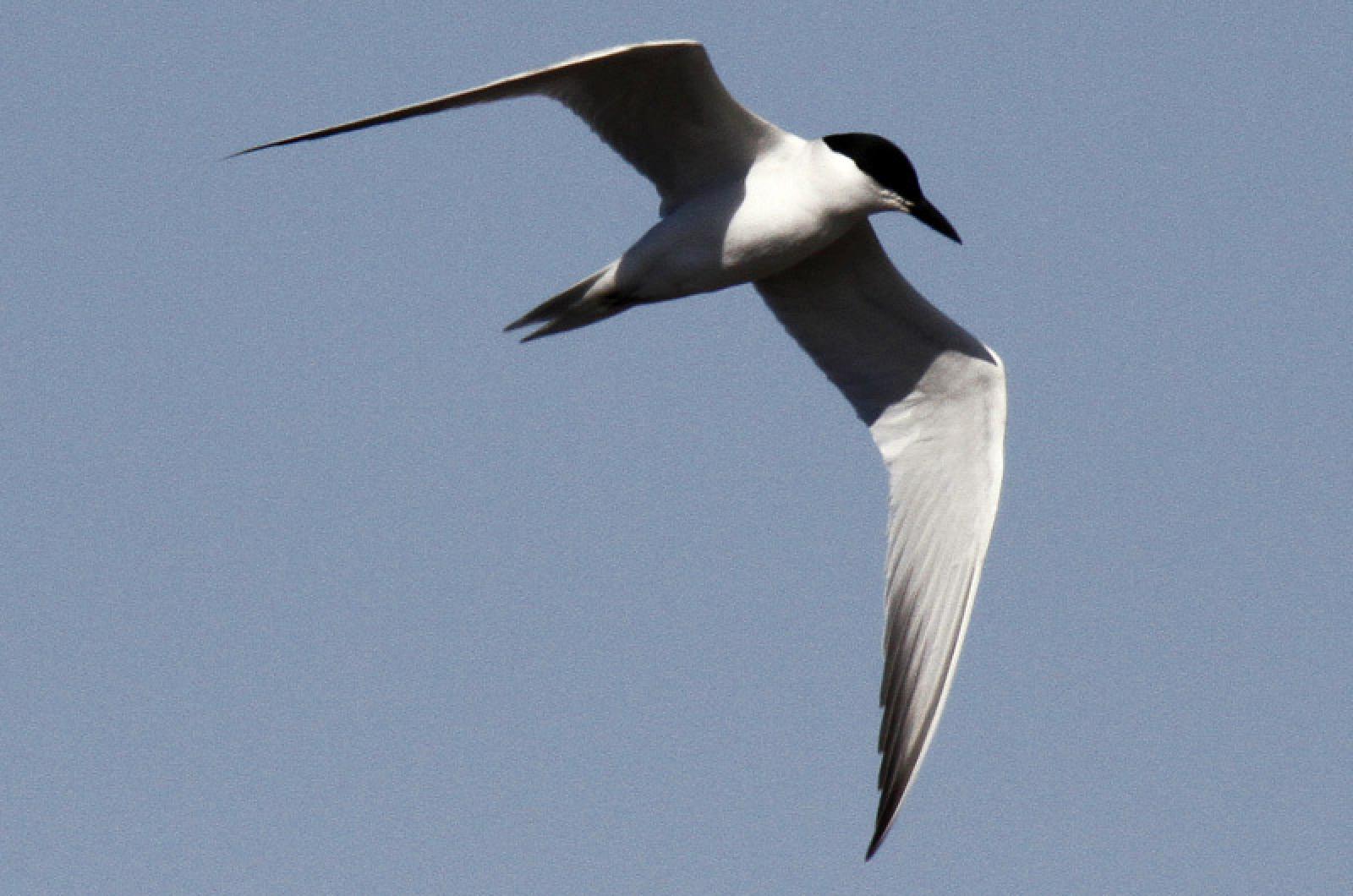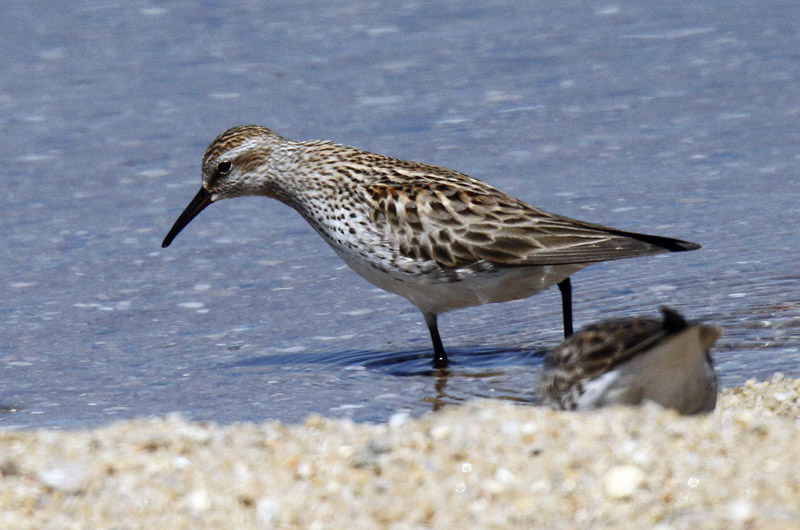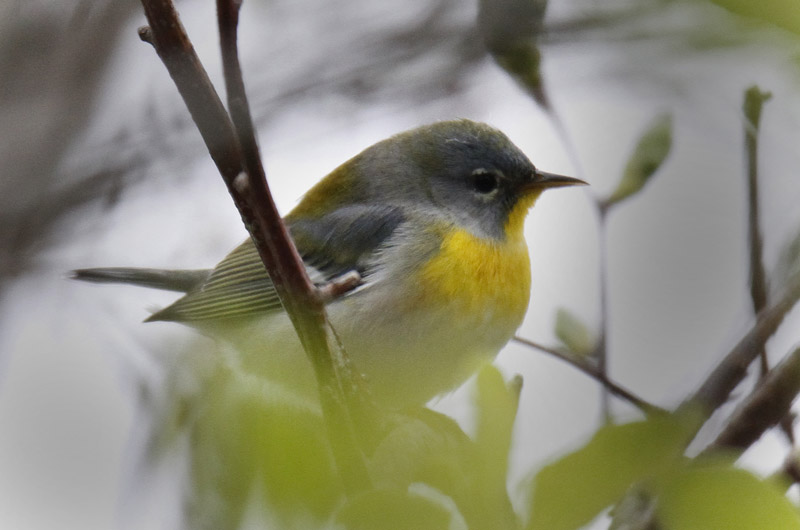The breeding season is now in full swing, and the first young birds born this year are leaving their nests and making their appearance. A young catbird with tufts of down still on its head was photographed by Sharon Simonin on May 24. And Jeff Bernier found a recently fledged cardinal on May 25. Please pay attention to an annual important reminder—recently fledged birds are not abandoned, even if they are not completely feathered. Their parents are likely hiding nearby, and will emerge to take care of their offspring after you leave. So please leave the baby birds alone, as their parents can take care of them much better than we can. There are also reports of young mute swans, Canada geese, and American oystercatchers.
There are three species we need to keep an eye out for. The Island populations of two species, Carolina wren and barn owl, were wiped out by the cold, snow and ice of the winter past. Only a few Carolina wrens were observed during the Felix Neck bird-a-thon, when there were more than 30 birders out scouring the Island for birds on May 15 and 16. This contrasts to the past many years when the wrens were widespread and nesting in just about everyone’s yard. Barn owls were also decimated. I heard a barn owl screeching in Katama about a month ago, but that may be the only record of one this spring.
Fish crows are another interesting species. They have been present every winter since 2009, part of the flock of the so-called commuter crows that roost overnight on the Vineyard and commute daily to and from the Cape. A year ago, we had a group of five fish crows that stayed, day and night, around Tisbury Marketplace into July. They were watched carefully but no evidence of breeding was found. Are any fish crows still here this year?
There are a few observations that any observant person can make to confirm a species as a breeding species. Obviously, seeing them on their nest, or seeing them feeding young birds, will confirm their breeding status, but other more subtle observations can be made. These include observing them either carrying plant material to be used in nest construction, or carrying food to feed a baby bird. These observations confirm a breeding species even if other details are not observed. A bird is unlikely to be carrying plant material or food unless they are nesting. These standards were established decades ago, for use in breeding bird atlases. Mass Audubon has used these standards twice for their state-wide atlases.
The sandhill crane mentioned in last week’s column, which was first reported on May 13 at the Keith Farm, moved a little bit north to Flanders field in Chilmark on May 17. John Nelson found it there on May 19 and it was still there as of May 22, as both Allan Keith and Bob Shriber saw it there. On May 23, Warren Woessner found a sandhill crane at the Farm Institute. It is hard to say whether it is the same sandhill crane. Sightings of this species are becoming more frequent. State-wide there have been numerous sighting of this species this spring, and they are now breeding in southwestern Massachusetts.
On May 23, Lanny McDowell and Pete Gilmore spotted a gull-billed tern a little bit west of Black Point Pond. This species is about the size of our common and roseate terns, but has a stouter black bill and its tail is not as deeply forked. They are also more likely to be hawking insects over fields and marshes than our other terns. This species is not a regular visitor, as it appears on Island every decade or so.
Bird Sightings
Perhaps the most intriguing sighting of the week is Penny Uhlendorf’s report of a pair of wood ducks investigating a possible nesting site near her house. The male chattered away while the female checked out the site. Apparently the site did not meet their expectations as they moved on. A nest box somewhere nearby seems appropriate, as this handsome duck is now a scarce breeder on the Island.
Waterbirds are still on the move. Lee Ellsworth found a common loon, great egret and snowy egret at Hickory Cove on Chappaquiddick. And Allan Keith found two snowy egrets at Harriph’s Creek bridge in Chilmark on May 20. At this time of the year, the egrets are likely to be nesting. It would be nice to locate their nesting colonies—plural because the snowy egret sightings are at opposite ends of the Island.
Terns are still migrating past us, in addition to those that are starting to nest here. Allan Keith made the round trip from Norton Point to Cape Pogue and back on May 19, and noted larger numbers on return trip. Roseate terns had increased from 40 to more than 100, and common terns increased from 500 to 1,500. This increase is likely due to an approaching storm causing these ocean foraging migrants to seek the nearest land. This large flock also included one black tern. Soo Whiting, Warren Woessner and Bob Shriber joined Mr. Keith for a return trip to these beaches on May 23. There were only 400 or so terns.
John Nelson counted 11 black skimmers at Eel Pond on May 20, the largest number he has ever seen there.
Lanny McDowell, Pete Gilmore and Warren Woessner birded Norton Point on May 22, with their highlights being four white-rumped sandpipers among the brilliantly-colored ruddy turnstones. On the same day, Allan Keith spotted a spotted sandpiper, a species that used to breed on the shorelines of every pond but now is only seen during migration.
On the songbird front, Ken Magnuson and both Kelly and Sue Spencer spotted a white-eyed vireo at Fulling Mill Brook on May 25. I have long thought that this species breeds there, but have never been able to find any evidence of it. Lanny McDowell thinks they probably nested at Cape Poge a few years back, and Bob Shriber reports they have nested near the Brickyard in Chilmark in past years.
Lanny McDowell found a blackpoll warbler. This species is always one of the last to migrate through, indicating the end of the migration is near, but not over. Soo Whiting, Warren Woessner, Bob Shriber and Allan Keith found a black-throated green warbler on Cape Pogue.
Bob Shriber found another black-throated green warbler at Waskosim’s Rock Reservation on May 24. And that same day, Pete Gilmore, Lanny McDowell and Soo Whiting found a magnolia warbler, only the second time ever she has seen that species in her yard. Her brown thrasher also arrived that same day. Matt Pelikan reports some good birds along Panhandle Road in West Tisbury on May 25. He found two blue-winged warblers having a dispute, a flock of cedar waxwings, and he heard a black-billed cuckoo calling.
That same morning, David Padulo observed several pairs of American redstarts at Great Rock Bight Preserve. They are a common breeding species there, and it is quite easy to get close-up looks at these ever-active warblers.
And last but not least, John Nelson observed two leucistic (mostly white) song sparrows just south of Crystal Lake. One has been present there for two years. The second, slightly more white, individual was spotted a couple of weeks ago. Now both have been seen together. To quote Captain Nelson, “WILD!”
There are lots of birds around, so please get out looking for them, and be sure to report your bird sightings to birds@mvgazette.com.
Robert Culbert leads guided birding tours and is an ecological consultant living in Vineyard Haven.






Comments (1)
Comments
Comment policy »